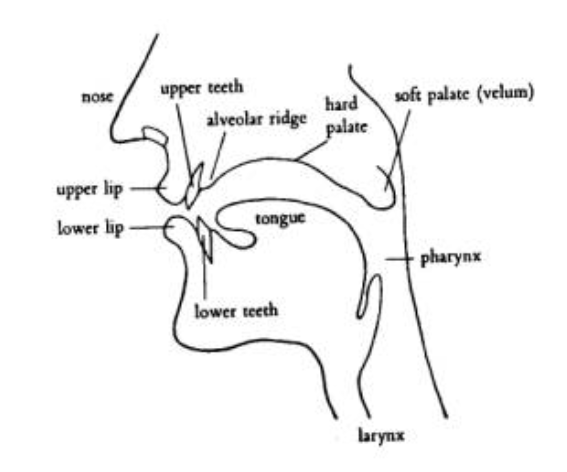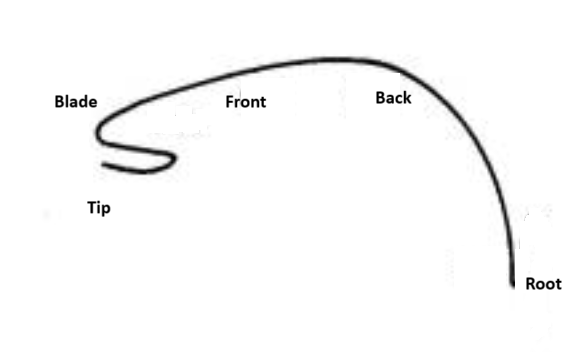Diagram of the Organs of Speech
Producing speech as sound is a complicated system that involves several parts of the mouth, throat and nose. Here is a diagram showing the seven main elements.
Dee Lynn
1/6/20253 min read


Let's learn about how the organs of speech work. Speech organs, also know as articulators, are what we use to produce these sounds.
There are seven main speech articulators:
Pharynx: This is a tube above your voice box (larynx). It splits at the top, one part going to the back of your mouth and the other towards your nose. You can see the back of your pharynx if you open your mouth wide and look in a mirror.
Velum/Soft Palate: This is at the back of the roof of your mouth. It can move up or down. Usually, it moves up to stop air from going through your nose when you speak. Your tongue touches it when you make sounds like /k/ (as in "cat") and /g/ (as in "go"). These sounds are called "velar" sounds.
Hard Palate: This is the hard part of the roof of your mouth. You can feel its smooth curve with your tongue.
Alveolar Ridge: This is the area just behind your top front teeth. It has small ridges. You can feel it with your tongue. Sounds made with your tongue touching this area, like /t/ (as in "top") and /d/ (as in "dog"), are called "alveolar" sounds.
Tongue: This is a very important articulator. It can move into many positions and shapes. It has different parts: the tip, blade, front, back, and root.
Teeth (Upper and Lower): Most people have teeth on the sides of their mouth. The tongue touches the upper teeth for many sounds. Sounds made with the tongue touching the front teeth are called "dental" sounds.
Lips: Your lips are important for speech. They can press together (for sounds like /p/ as in "pen"), touch your teeth (for sounds like /f/ as in "fan" and /v/ as in "van"), or round into a circle (for vowel sounds like /u:/ as in "food"). Sounds made with both lips are called "bilabial," and sounds made with your lips and teeth are called "labiodental."
Besides these seven main articulators, there are three other important parts:
Larynx (Voice Box): This is also important for making sounds. You can feel it vibrate (your "Adam's apple") when you make voiced sounds like /z/ (as in "zoo").
Jaws: Moving your jaws (especially your lower jaw) helps with speaking. However, they don't directly touch other articulators like the tongue or lips do.
Nose and Nasal Cavity: These are important for nasal sounds like /m/ (as in "man") and /n/ (as in "no"). But they aren't considered articulators in the same way as the seven main ones.


5 Tongue Positions
Understanding the intricate movements of the tongue is crucial for mastering pronunciation in any language. The tongue, a highly versatile muscle, can be divided into five main parts for phonetic analysis: the tip, blade, front, back, and root. Each of these plays a distinct role in shaping the vocal tract and producing different sounds.
Tip: The tongue tip is the most agile part, responsible for sounds like /t/, /d/, /n/, /l/, and /θ/ (as in "thin") and /ð/ (as in "this"). It achieves this by making contact with the alveolar ridge (the gum ridge behind the upper teeth) or the teeth themselves.
Blade: Located just behind the tip, the blade is used in conjunction with the tip for some sounds, but it also has its own set of articulations. For example, in some languages, the blade rises towards the alveolar ridge or palate to produce sounds like /ʃ/ (as in "ship") and /ʒ/ (as in "vision").
Front: The front of the tongue, sometimes referred to as the "dorsum," is involved in creating vowel sounds, particularly front vowels like /i/ (as in "see") and /e/ (as in "bed"). It does this by raising or lowering towards the hard palate (the roof of the mouth).
Back: The back of the tongue is crucial for producing back vowels like /u/ (as in "food") and /o/ (as in "go"), as well as velar consonants like /k/ and /ɡ/. It retracts and raises towards the soft palate (velum) to constrict the airflow and create these sounds.
Root: The root of the tongue, located at the very back, plays a less direct role in articulation compared to the other parts. However, it contributes to shaping the pharyngeal cavity, which influences the quality of vowels and can be involved in producing pharyngeal consonants in some languages.
By coordinating the movements of these five parts, the tongue can produce a vast array of sounds, enabling the rich diversity of human language. Understanding these movements is essential for both language learners and those studying phonetics and phonology.
Contact US
info@uspronunciation.com

